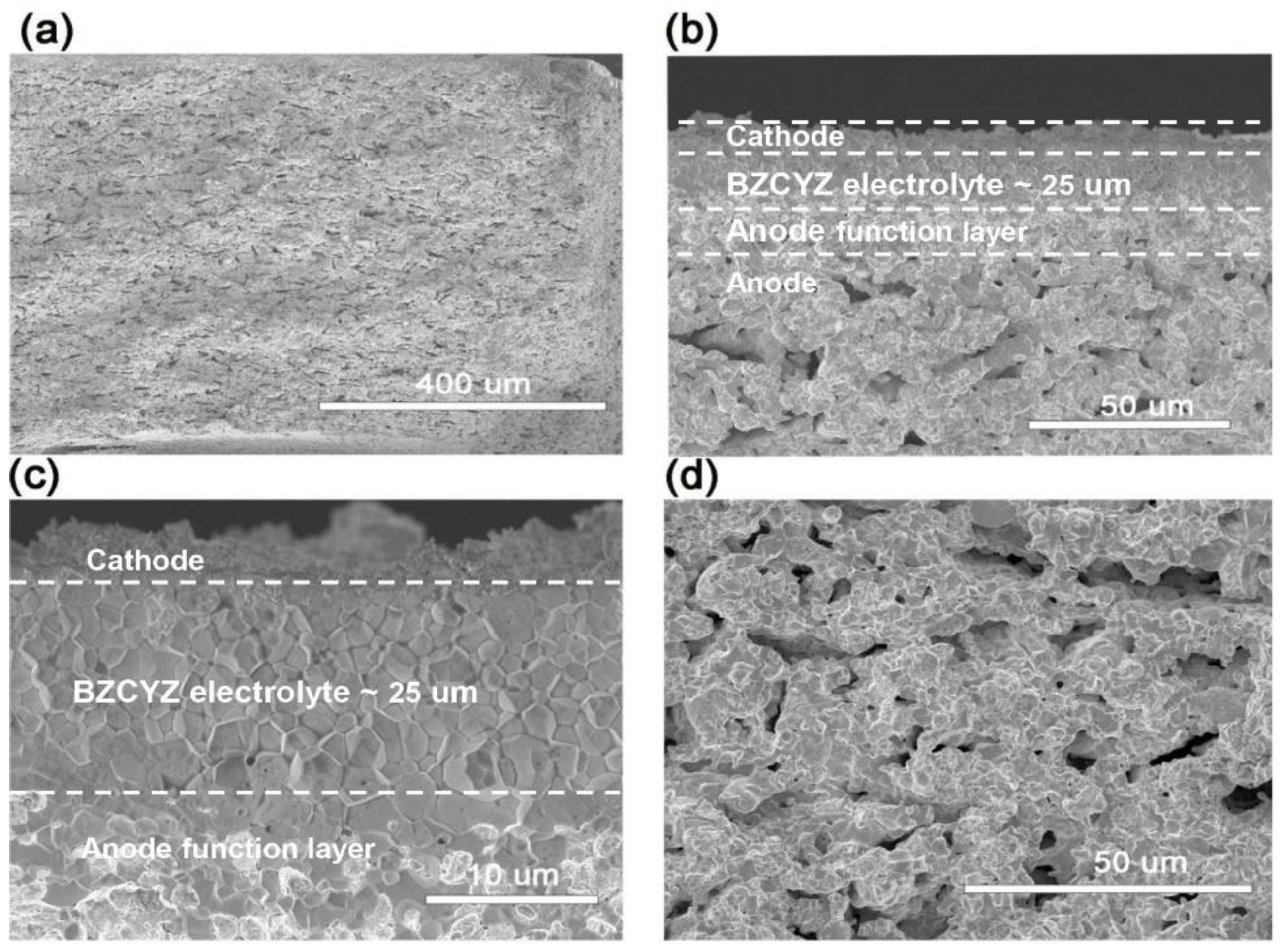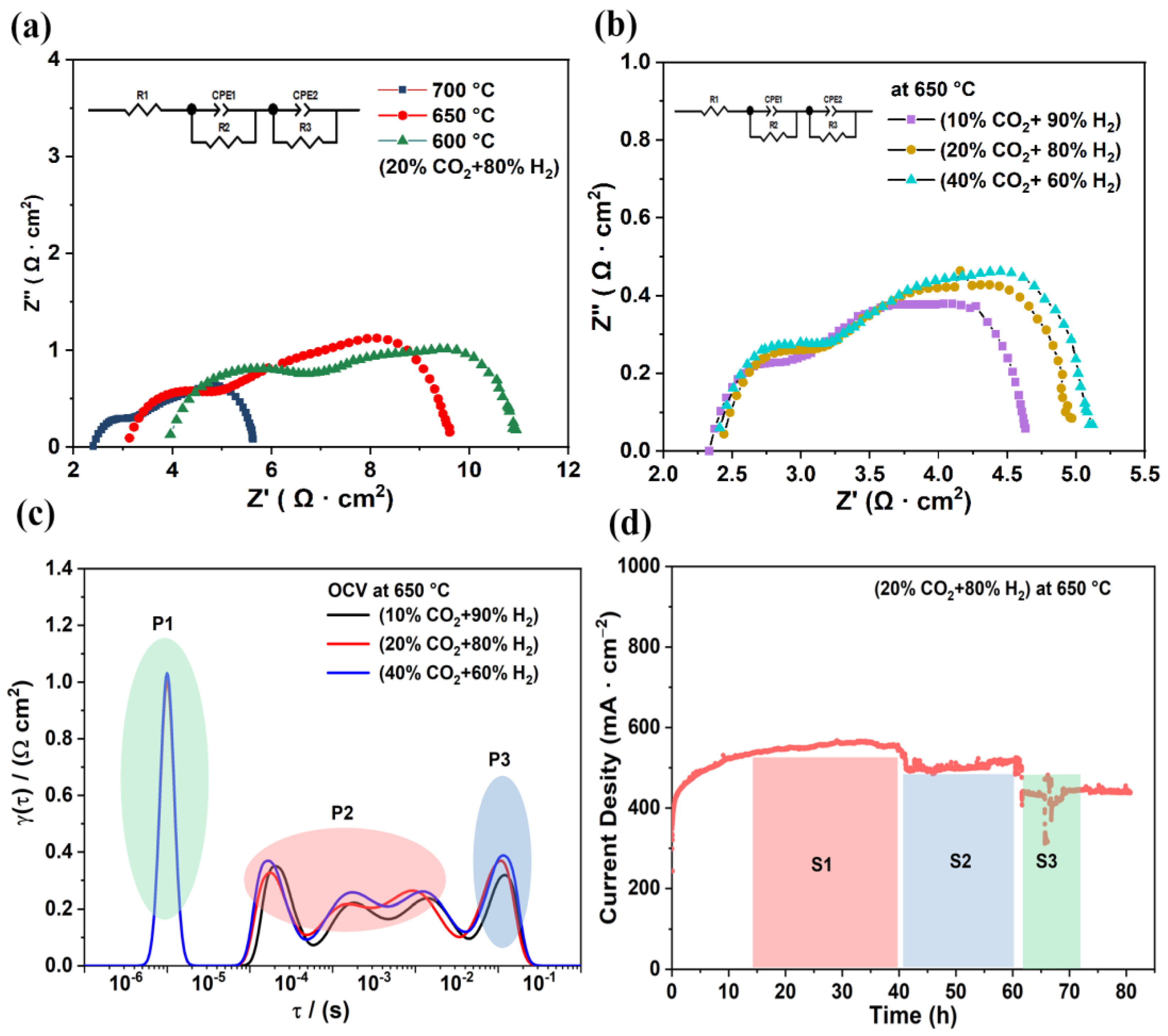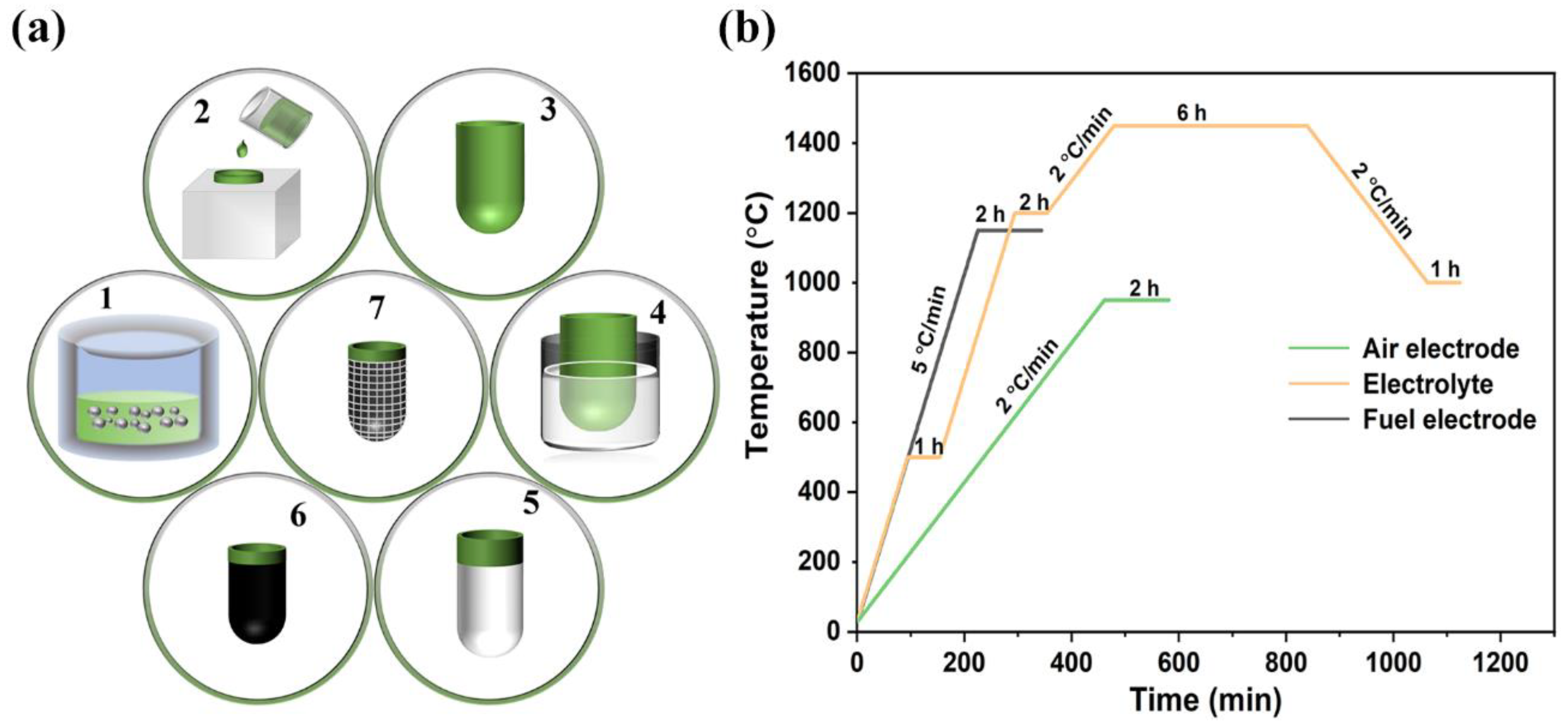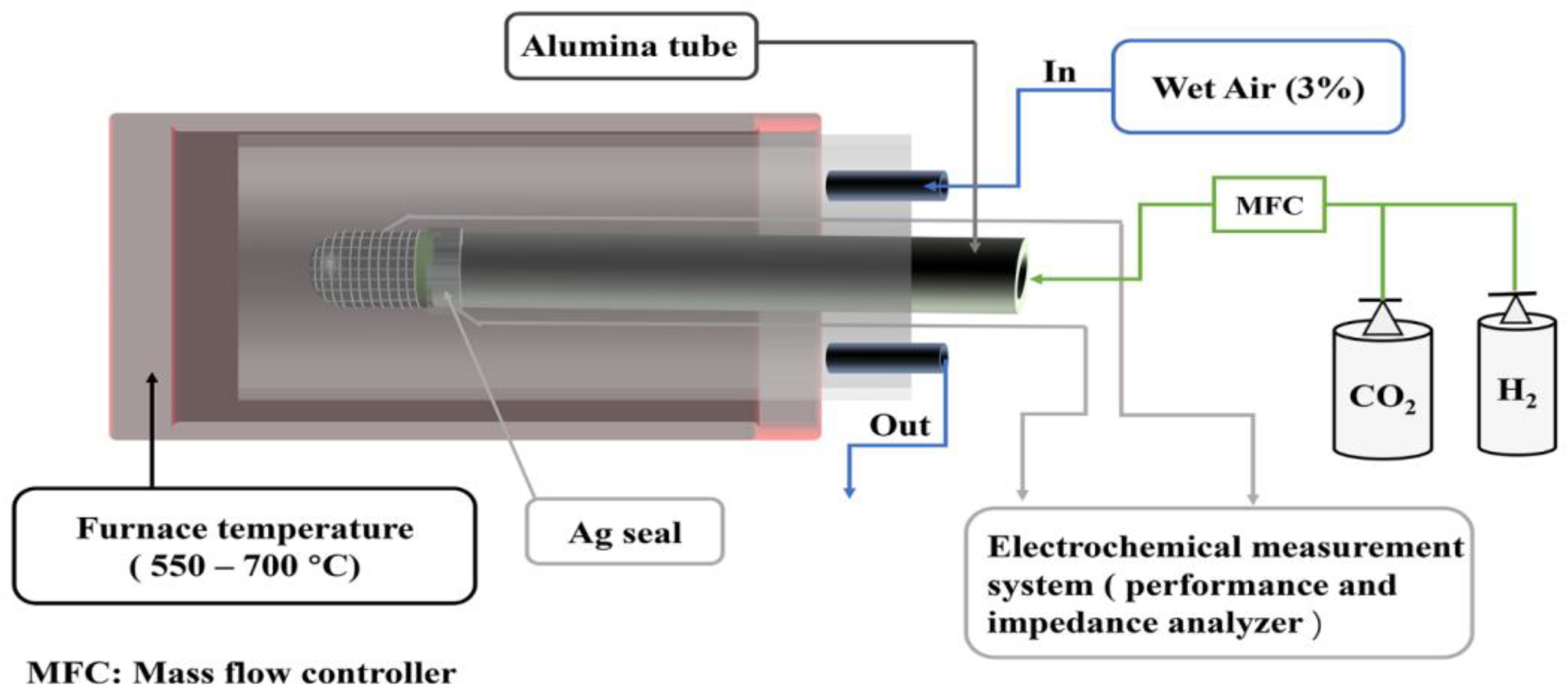Performance of Fuel Electrode-Supported Tubular Protonic Ceramic Cells Prepared through Slip Casting and Dip-Coating Methods
Abstract
1. Introduction
2. Results and Discussion
3. Materials and Methods
3.1. Synthesis and Characterization
3.2. Fabrication of Tubular SOCs via Slip Casting and Dip-Coating Methods
- (1)
- Slurry ball milling. NiO/BZCYZ fuel electrode slurry (Table 1) was prepared by ball milling at 200 r/min for 10 min.
- (2)
- Slip casting. NiO/BZCYZ fuel electrode slurry was poured into plaster molds, and the water in the slurry was absorbed by the porous dry plaster mold, forming a solid NiO-BZCYZ on the inner wall of the plaster specimen. Then, during the formation of the tubular structure, the mold remained filled with slurry for about 30 s until the desired shell thickness was reached. The excess slurry was poured out, and the wet plaster mold dried at room temperature.
- (3)
- Fettling and sintering. The NiO-BZCYZ tubular fuel electrode support was separated from the mold during the room-temperature dry process (about 5 h). The fuel electrode support was thoroughly dried at 25 °C and presintered at 1150 °C for 2 h to reinforce the support and decompose organic additives and graphite pore former.
- (4)
- Dip coating. After presintering the porous tubular fuel electrode support, the anode function layer (AFL, Table 2) films were prepared with the dip-coating method. The AFL paste was soaked and coated on the surface of the tube fuel electrode by dipping twice, and the electrolyte (Table 3) was dipped 5 times. The dipping speed, holding time and pulling speed were kept at 6 mm/s, 5 s, and 2 mm/s, respectively.
- (5)
- Electrolyte layer sintering. Similarly, the BZCYZ electrolyte thin layer was coated over AFL by the same method as Step (4) and then cofired for 6 h at 1450 °C. The Vickers hardness values of the obtained proton tubular fuel cells at different sintering temperatures are shown in Figure S3.
- (6)
- Cathode preparation and sintering. The cathode slurry paste was prepared by using LSCF (70% by weight), BZCYZ (30% by weight), and a suitable amount of conductive glue (6 wt% ethyl cellulose + 94 wt% terpilenol). The cathode paste was coated on the electrolyte and then sintered at 950 °C for 2 h.
- (7)
- Current collection preparation. The cathode surface was coated with silver grids, and a thin layer of silver paste was applied on the anode to collect the electric current. A silver wire was connected to the anode and cathode of the connecting section, and the current was directed outward.
3.3. Characterization
4. Conclusions
Supplementary Materials
Author Contributions
Funding
Data Availability Statement
Conflicts of Interest
Correction Statement
References
- Stambouli, A.; Traversa, E. Solid oxide fuel cells (SOFCs): A review of an environmentally clean and efficient source of energy. Renew. Sust. Energ. Rev. 2002, 6, 433–455. [Google Scholar] [CrossRef]
- Pieta, I.; Epling, W.; Kazmierczuk, A.; Lisowski, P.; Nowakowski, R.; Serwicka, E. Waste into fuel-catalyst and process development for MSW valorisation. Catalysts 2018, 8, 113. [Google Scholar] [CrossRef]
- Khan, M.; Iltaf, A.; Ishfaq, H.; Khan, F.; Tanveer, W.; Song, R.-H.; Mehran, M.; Saleem, M.; Hussain, A.; Masaud, Z. Flat-tubular solid oxide fuel cells and stacks: A review. J. Asian Ceram. Soc. 2021, 9, 754–770. [Google Scholar] [CrossRef]
- Cao, J.; Ji, Y.; Shao, Z. Perovskites for protonic ceramic fuel cells: A review. Energ. Environ. Sci. 2022, 15, 2200–2232. [Google Scholar] [CrossRef]
- Zheng, Y.; Wang, J.; Yu, B.; Zhang, W.; Chen, J.; Qiao, J.; Zhang, J. A review of high temperature co-electrolysis of H2O and CO2 to produce sustainable fuels using solid oxide electrolysis cells (SOECs): Advanced materials and technology. Chem. Soc. Rev. 2017, 46, 1427–1463. [Google Scholar] [CrossRef] [PubMed]
- Chen, B.; Xu, H.; Zhang, Y.; Dong, F.; Tan, P.; Zhao, T.; Ni, M. Combined methane reforming by carbon dioxide and steam in proton conducting solid oxide fuel cells for syngas/power co-generation. Int. J. Hydrogen. Energ. 2019, 44, 15313–15321. [Google Scholar] [CrossRef]
- Ricote, S.; Kee, R.; Coors, W. Slip casting and solid-state reactive sintering of BCZY(BaCexZr0.9−xY0.1O3-δ)-NiO/BCZY half-cells. Membranes 2022, 12, 242. [Google Scholar] [CrossRef]
- Zhou, J.; Ye, X.; Shao, L.; Zhang, X.; Qian, J.; Wang, S. A promising direct carbon fuel cell based on the cathode-supported tubular solid oxide fuel cell technology. Electrochim. Acta 2012, 74, 267–270. [Google Scholar] [CrossRef]
- Panthi, D.; Hedayat, N.; Woodson, T.; Emley, B.; Du, Y. Tubular solid oxide fuel cells fabricated by a novel freeze casting method. J. Am. Ceram. Soc. 2020, 103, 878–888. [Google Scholar] [CrossRef]
- Hodjati-Pugh, O.; Dhir, A.; Steinberger-Wilckens, R. The development of current collection in micro-tubular solid oxide fuel cells-a review. Appl. Sci. 2021, 11, 1077. [Google Scholar] [CrossRef]
- Kreuer, K. Aspects of the formation and mobility of protonic charge carriers.pdf. Solid State Ion. 1999, 125, 285–302. [Google Scholar] [CrossRef]
- Pornprasertsuk, R.; Ramanarayanan, P.; Musgrave, C.; Prinz, F. Predicting ionic conductivity of solid oxide fuel cell electrolyte from first principles. J. Appl. Phys. 2005, 98, 103513. [Google Scholar] [CrossRef]
- Manning, P.; Sirman, J.; De Souza, R.; Kilner, J. The kinetics of oxygen transport in 9.5 mol% single crystal yttria stabilised zirconia. Solid State Ion. 1997, 100, 1–10. [Google Scholar] [CrossRef]
- Xie, K.; Yan, R.; Chen, X.; Dong, D.; Wang, S.; Liu, X.; Meng, G. A new stable BaCeO3-based proton conductor for intermediate-temperature solid oxide fuel cells. J. Alloys Compd. 2009, 472, 551–555. [Google Scholar] [CrossRef]
- Tao, B.; Irvine, J. A stable, easily sintered proton-conducting oxide electrolyte for moder-ate-temperature fuel cells and electrolyze. Adv. Mater. 2006, 18, 1581–1584. [Google Scholar] [CrossRef]
- Azaza, N.; Elleuch, S.; Rasheed, M.; Gindre, D.; Abid, S.; Barille, R.; Abid, Y.; Ammar, H. 3-(p-nitrophenyl)Coumarin derivatives: Synthesis, linear and nonlinear optical properties. Opt. Mater. 2019, 96, 109328. [Google Scholar] [CrossRef]
- Bello, I.; Zhai, S.; He, Q.; Cheng, C.; Dai, Y.; Chen, B.; Zhang, Y.; Ni, M. Materials development and prospective for protonic ceramic fuel cells. Int. J. Energy Res. 2022, 46, 2212–2240. [Google Scholar] [CrossRef]
- Timurkutluk, C.; Timurkutluk, B.; Kaplan, Y. Experimental optimization of the fabrication pa-rameters for anode-supported micro-tubular solid oxide fuel cells. Int. J. Hydrogen Energy 2020, 45, 23294–23309. [Google Scholar] [CrossRef]
- Ren, C.; Xu, P.; Zhang, Y.; Liu, T. Understanding the polymer binder effect on the microstructure and performance of micro-tubular solid oxide fuel cells with continuously graded pores fabricated by the phase inversion method. Appl. Surf. Sci. 2023, 612, 155928. [Google Scholar] [CrossRef]
- Sun, H.; Zhang, S.; Li, C.; Rainwater, B.; Liu, Y.; Zhang, L.; Zhang, Y.; Li, C.; Liu, M. Atmospheric plasma-sprayed BaZr0.1Ce0.7Y0.1Yb0.1O3-δ(BZCYYb) electrolyte membranes for intermediate-temperature solid oxide fuel cells. Ceram. Int. 2016, 42, 19231–19236. [Google Scholar] [CrossRef]
- Zakaria, Z.; Mat, Z.; Hassan, S.; Kar, Y. A review of solid oxide fuel cell component fabrication methods toward lowering temperature. Int. J. Energy Res. 2020, 44, 594–611. [Google Scholar] [CrossRef]
- Sammes, N.M.; Du, Y. Fabrication and characterization of tubular solid oxide fuel cells. Int. J. Appl. Ceram. Technol. 2007, 4, 89–102. [Google Scholar] [CrossRef]
- Tian, J.; Ren, Y.; Liu, L.; Guo, Q.; Sha, N.; Zhao, Z. Photothermal catalysis for CO2 convert into C1-C3 hydrocarbons by proton conductor BZCYMater. Res. Express 2020, 7, 085504. [Google Scholar] [CrossRef]
- Wang, Z.; Ding, L.; Yu, S.; Xu, H.; Hao, X.; Sun, Y.; He, T. Effect of two different ZnO addition strategies on the sinterability and conductivity of the BaZr0.4Ce0.4Y0.2O3−δ proton-conducting ceramic electrolyte. ACS Appl. Energy Mater. 2022, 5, 3369–3379. [Google Scholar] [CrossRef]
- Yoo, Y.; Lim, N. Performance and stability of proton conducting solid oxide fuel cells based on yttrium-doped barium cerate-zirconate thin-film electrolyte. J. Power Sources 2013, 229, 48–57. [Google Scholar] [CrossRef]
- Zuo, C.; Zha, S.; Liu, M.; Hatano, M.; Uchiyama, M. Ba(Zr0.1Ce0.7Y0.2)O3-δ as an electrolyte for low-temperature solid-oxide fuel cells. Adv. Mater. 2006, 18, 3318–3320. [Google Scholar] [CrossRef]
- Ding, Z.; Yang, Z.; Zhao, D.; Deng, X.; Ma, G. A cobalt-free perovskite-type La0.6Sr0.4Fe0.9Cr0.1O3-δ cathode for proton-conducting intermediate temperature solid oxide fuel cells. J. Alloys Compd. 2013, 550, 204–208. [Google Scholar] [CrossRef]
- Yang, L.; Wang, S.; Blinn, K.; Liu, M.; Liu, Z.; Cheng, Z.; Liu, M. Enhanced sulfur and coking tolerance of a mixed ion conductor for SOFCs: BaZr0.1Ce0.7Y0.2-XYbxO3-δ. Science 2009, 326, 126–129. [Google Scholar] [CrossRef]
- Zhao, F.; Jin, C.; Yang, C.; Wang, S.; Chen, F. Fabrication and characterization of anode-supported micro-tubular solid oxide fuel cell based on BaZr0.1Ce0.7Y0.1Yb0.1O3-δ electrolyte. J. Power Sources 2011, 196, 688–691. [Google Scholar] [CrossRef]
- Ren, C.; Wang, S.; Liu, T.; Lin, Y.; Chen, F. Fabrication of micro-tubular solid oxide fuel cells using sulfur-free polymer binder via a phase inversion method. J. Power Sources 2015, 290, 1–7. [Google Scholar] [CrossRef]
- Yang, C.; Jin, C.; Chen, F. Micro-tubular solid oxide fuel cells fabricated by phase-inversion method. Electrochem. Commun. 2010, 12, 657–660. [Google Scholar] [CrossRef]
- Dong, Y.; Chen, C.; Liu, M.; Rainwater, B.H.; Bai, Y. Enhancement of electrochemical properties, impedance and resistances of micro-tubular IT-SOFCs with novel asymmetric structure based on BaZr0.1Ce0.7Y0.1Yb0.1O3-δ proton conducting electrolyte. Fuel Cells 2020, 1, 70–79. [Google Scholar] [CrossRef]
- Wang, Q.; Luo, T.; Tong, Y.; Dai, M.; Miao, X.; Ricote, S.; Zhan, Z.; Chen, M. Large-area protonic ceramic cells for hydrogen purification. Sep. Purif. Technol. 2022, 295, 121301. [Google Scholar] [CrossRef]
- Jaiswal, N.; Tanwar, K.; Suman, R.; Kumar, D.; Uppadhya, S.; Parkash, O. A brief review on ceria based solid electrolytes for solid oxide fuel cells. J. Alloys Compd. 2019, 781, 984–1005. [Google Scholar] [CrossRef]
- Yang, C.; Ren, C.; Yu, L.; Jin, C. High performance intermediate temperature micro-tubular SOFCs with Ba0.9Co0.7Fe0.2Nb0.1O3-δ as cathode. Int. J. Hydrogen Energy 2013, 38, 15348–15353. [Google Scholar] [CrossRef]
- Huang, Q.; Wang, B.; Qu, W.; Hui, R. Impedance diagnosis of metal-supported SOFCs with SDC as electrolyte. J. Power Sources 2009, 191, 297–303. [Google Scholar] [CrossRef]
- Cao, D.; Zhou, M.; Yan, X.; Liu, Z.; Liu, J. High performance low-temperature tubular protonic ceramic fuel cells based on barium cerate-zirconate electrolyte. Electrochem. Commun. 2021, 125, 106986. [Google Scholar] [CrossRef]
- Gan, L.; Ye, L.; Wang, S.; Liu, M.; Tao, S.; Xie, K. Demonstration of direct conversion of CO2/H2O into syngas in a symmetrical proton-conducting solid oxide electrolyze. Int. J. Hydrogen Energy 2016, 41, 1170–1175. [Google Scholar] [CrossRef]
- Zhang, X.; Ye, L.; Xie, K. Electrochemical reduction of CO2 with exsolved metal-oxide interfaces in a proton-conducting solid oxide electrolyze. Energ. Fuel. 2022, 36, 11576–11583. [Google Scholar] [CrossRef]
- Sun, S.; Cheng, Z. Electrochemical behaviors for Ag, LSCF and BSCF as oxygen electrodes for proton conducting IT-SOFC. J. Electrochem. Soc. 2017, 164, F3104–F3113. [Google Scholar] [CrossRef]
- Clematis, D.; Presto, S.; Carpanese, M.; Barbucci, A.; Deganello, F.; Liotta, L.F.; Aliotta, C.; Viviani, M. Distribution of relaxation times and equivalent circuits analysis of Ba0.5Sr0.5Co0.8Fe0.2O3−δ. Catalysts 2019, 9, 441. [Google Scholar] [CrossRef]
- Kadri, E.; Dhahri, K.; Zaafouri, A.; Krichen, M.; Rasheed, M.; Khirouni, K.; Moltech-Anjo, R. Ac conductivity and dielectric behavior of a−Si: H/c−Si1−y Gey/p−Si thin films synthesized by molecular beam epitaxial method. J. Alloys Compd. 2017, 705, 708–713. [Google Scholar] [CrossRef]
- Zhang, L.; Sun, W.; Xu, C.; Ren, R.; Yang, X.; Qiao, J.; Wang, Z.; Sun, K. Attenuating a metal-oxygen bond of a double perovskite oxide: Via anion doping to enhance its catalytic activity for the oxygen reduction reaction. J. Mater. Chem. A 2020, 8, 14091–14098. [Google Scholar] [CrossRef]
- Xia, W.; Liu, X.; Jin, F.; Jia, X.; Shen, Y.; Li, J. Evaluation of calcium co-doping in double perovskite PrBaCo2O5+δ as cathode material for IT-SOFCs. Electrochim. Acta. 2020, 364, 137274. [Google Scholar] [CrossRef]
- Mirzababaei, J.; Chuang, S. La0.6Sr0.4Co0.2Fe0.8O3 perovskite: A stable anode catalyst for direct methane solid oxide fuel cells. Catalysts 2014, 4, 146–161. [Google Scholar] [CrossRef]
- Pan, Y.; Zhang, H.; Xu, K.; Zhou, Y.; Zhao, B.; Yuan, W.; Sasaki, K.; Choi, Y.; Chen, Y.; Liu, M. A high-performance and durable direct NH3 tubular protonic ceramic fuel cell integrated with an internal catalyst layer. Appl. Catal. B-Environ. 2022, 306, 121071. [Google Scholar] [CrossRef]
- Vøllestad, E.; Strandbakke, R.; Tarach, M.; Catalán-Martínez, D.; Fontaine, M.; Beeaff, D.; Clark, D.; Serra, J.; Norby, T. Mixed proton and electron conducting double perovskite anodes for stable and efficient tubular proton ceramic electrolysers. Nat. Mater. 2019, 18, 752–759. [Google Scholar] [CrossRef]







| Components | Mass or Volume |
|---|---|
| NiO | 6 g |
| BZCYZ | 4 g |
| Graphite | 1 g |
| Arabic gum | 0.2 g |
| H2O | 100 mL |
| Components | Mass or Volume |
|---|---|
| NiO | 5 g |
| BZCYZ | 5 g |
| PVB | 0.5 g |
| TEA | 0.52 g |
| PEG | 0.32 g |
| Alcohol | 50 mL |
| Components | Mass or Volume |
|---|---|
| BZCYZ | 10 g |
| TEA | 5 g |
| PVB | 0.5 g |
| Alcohol | 50 mL |
Disclaimer/Publisher’s Note: The statements, opinions and data contained in all publications are solely those of the individual author(s) and contributor(s) and not of MDPI and/or the editor(s). MDPI and/or the editor(s) disclaim responsibility for any injury to people or property resulting from any ideas, methods, instructions or products referred to in the content. |
© 2023 by the authors. Licensee MDPI, Basel, Switzerland. This article is an open access article distributed under the terms and conditions of the Creative Commons Attribution (CC BY) license (https://creativecommons.org/licenses/by/4.0/).
Share and Cite
Xiao, Y.; Wang, M.; Bao, D.; Wang, Z.; Jin, F.; Wang, Y.; He, T. Performance of Fuel Electrode-Supported Tubular Protonic Ceramic Cells Prepared through Slip Casting and Dip-Coating Methods. Catalysts 2023, 13, 182. https://doi.org/10.3390/catal13010182
Xiao Y, Wang M, Bao D, Wang Z, Jin F, Wang Y, He T. Performance of Fuel Electrode-Supported Tubular Protonic Ceramic Cells Prepared through Slip Casting and Dip-Coating Methods. Catalysts. 2023; 13(1):182. https://doi.org/10.3390/catal13010182
Chicago/Turabian StyleXiao, Youcheng, Mengjiao Wang, Di Bao, Zhen Wang, Fangjun Jin, Yaowen Wang, and Tianmin He. 2023. "Performance of Fuel Electrode-Supported Tubular Protonic Ceramic Cells Prepared through Slip Casting and Dip-Coating Methods" Catalysts 13, no. 1: 182. https://doi.org/10.3390/catal13010182
APA StyleXiao, Y., Wang, M., Bao, D., Wang, Z., Jin, F., Wang, Y., & He, T. (2023). Performance of Fuel Electrode-Supported Tubular Protonic Ceramic Cells Prepared through Slip Casting and Dip-Coating Methods. Catalysts, 13(1), 182. https://doi.org/10.3390/catal13010182







